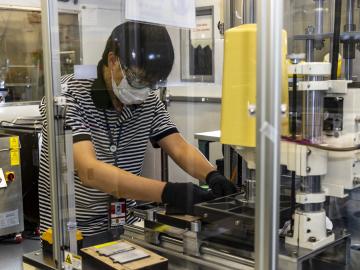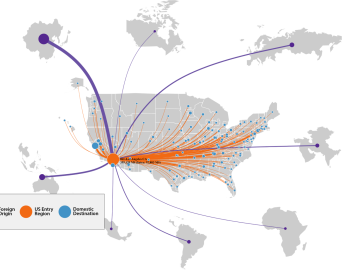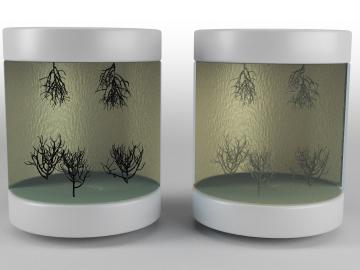
Filter News
Area of Research
- Biology and Environment (12)
- Computer Science (3)
- Electricity and Smart Grid (1)
- Energy Science (33)
- Fusion and Fission (10)
- Materials (7)
- Materials for Computing (7)
- National Security (1)
- Neutron Science (6)
- Quantum information Science (3)
- Sensors and Controls (1)
- Supercomputing (8)
- Transportation Systems (1)
News Topics
- (-) Bioenergy (15)
- (-) Energy Storage (21)
- (-) Fusion (9)
- (-) Grid (10)
- (-) Machine Learning (1)
- (-) Nanotechnology (10)
- (-) Quantum Science (12)
- (-) Transportation (21)
- 3-D Printing/Advanced Manufacturing (27)
- Advanced Reactors (2)
- Artificial Intelligence (7)
- Big Data (5)
- Biology (23)
- Biomedical (10)
- Biotechnology (5)
- Buildings (13)
- Chemical Sciences (7)
- Clean Water (8)
- Composites (6)
- Computer Science (32)
- Coronavirus (10)
- Critical Materials (8)
- Cybersecurity (5)
- Environment (42)
- Exascale Computing (3)
- Frontier (4)
- High-Performance Computing (19)
- Isotopes (12)
- ITER (4)
- Materials (32)
- Materials Science (23)
- Mathematics (1)
- Mercury (5)
- Microscopy (10)
- National Security (7)
- Neutron Science (21)
- Nuclear Energy (7)
- Physics (3)
- Polymers (5)
- Quantum Computing (5)
- Security (3)
- Space Exploration (4)
- Statistics (1)
- Summit (9)
Media Contacts

At the Department of Energy’s Oak Ridge National Laboratory, scientists use artificial intelligence, or AI, to accelerate the discovery and development of materials for energy and information technologies.

The Department of Energy’s Oak Ridge National Laboratory has licensed its award-winning artificial intelligence software system, the Multinode Evolutionary Neural Networks for Deep Learning, to General Motors for use in vehicle technology and design.

Esther Parish is one of eight scientists from the Department of Energy's Oak Ridge National Laboratory talking to students in nine schools across East Tennessee as part of National Environmental Education Week, or EE Week.

In his career focused on energy storage science, Jianlin Li has learned that discovering new ways to process and assemble batteries is just as important as the development of new materials.

Through a consortium of Department of Energy national laboratories, ORNL scientists are applying their expertise to provide solutions that enable the commercialization of emission-free hydrogen fuel cell technology for heavy-duty

A newly released dataset that tracks the movement of everything from food to gasoline across the United States by air, water, truck, rail and pipeline showed the value and tonnage of those goods rose significantly between 2012 and 2017.

Scientists at Oak Ridge National Laboratory have devised a method to identify the unique chemical makeup of every lithium-ion battery around the world, information that could accelerate recycling, recover critical materials and resolve a growing waste stream.

Using complementary computing calculations and neutron scattering techniques, researchers from the Department of Energy’s Oak Ridge and Lawrence Berkeley national laboratories and the University of California, Berkeley, discovered the existence of an elusive type of spin dynamics in a quantum mechanical system.

Scientists at Oak Ridge National Laboratory successfully demonstrated a technique to heal dendrites that formed in a solid electrolyte, resolving an issue that can hamper the performance of high energy-density, solid-state batteries.

Researchers at the Department of Energy’s Oak Ridge National Laboratory and the University of Tennessee are automating the search for new materials to advance solar energy technologies.


